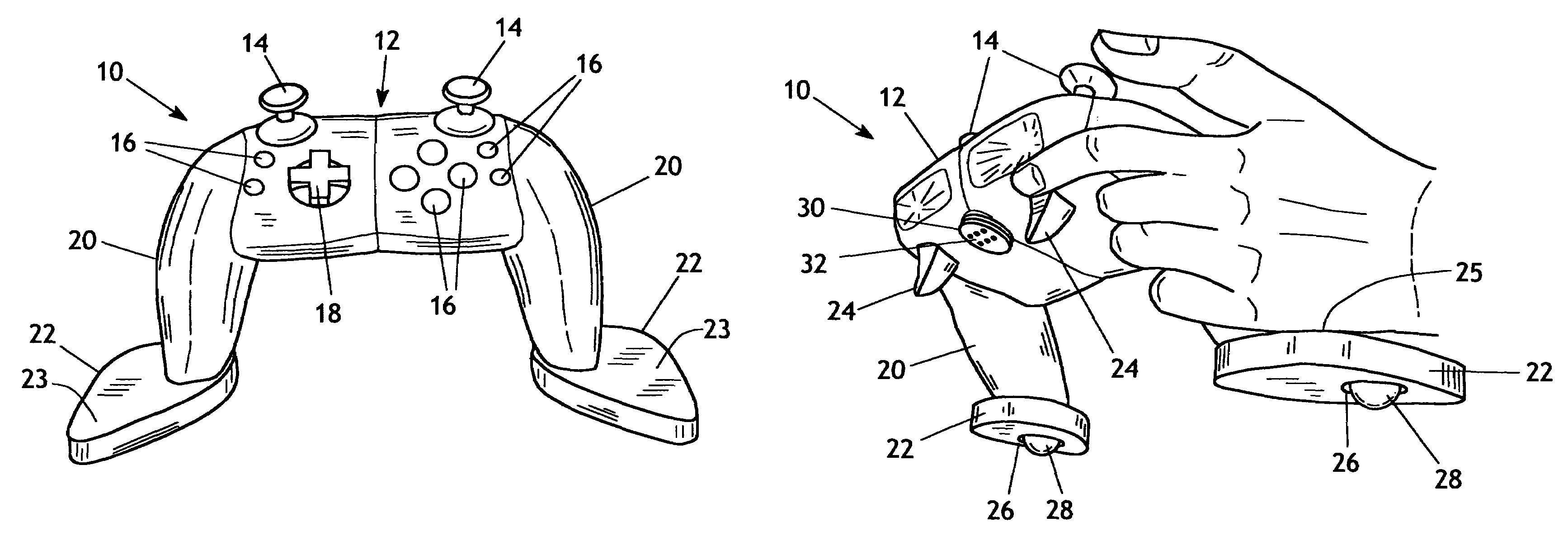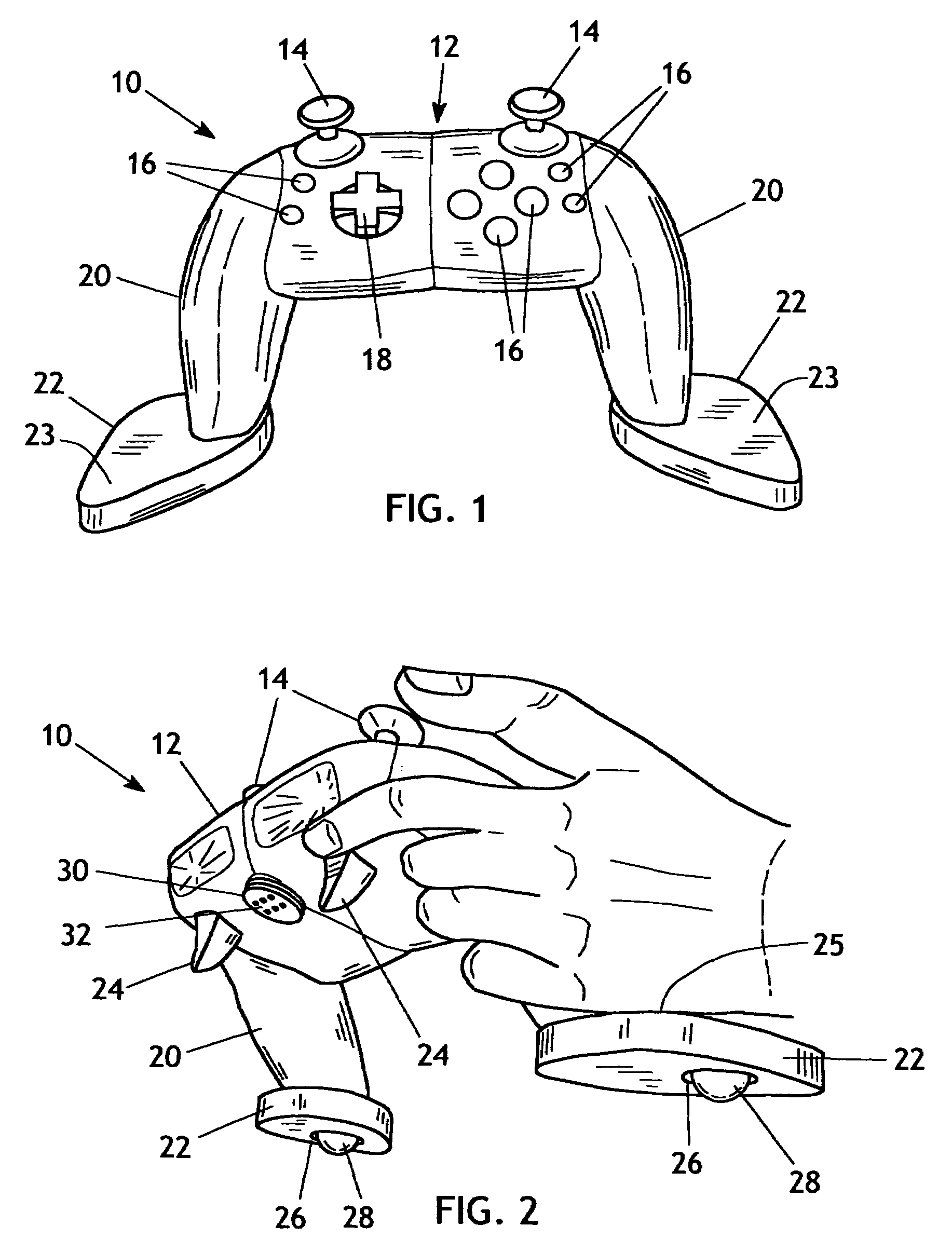With the emergence of computer and console video games, however, there are a number of inherent limitation in regard to the
video game controllers themselves and their related input components.
These limitations range from functionality and adaptability, to general ergonomics.
This device, however, by nature of its construction cannot provide quick
reflex aiming such as that which is possible with a mouse
input device, and therefore is limited to slower steadier applications.
It is noteworthy to mention that the keyboard is generally a poor choice as a
video gaming input device because it lacks the quick
reflex, finger tip functionality such as that found on video game pads for instance.
What is more the
computer mouse by nature of it construction cannot provide slower steadier aiming such as that which is possible with a flight yoke /
joystick and therefore is limited to quick
reflex aiming applications.
However it lacks the slow steady aiming abilities of the hand operated joysticks, primarily due to the fact that the
thumb operated joysticks on a typical game pad are too responsive and lack the control of an entirely hand operated
joystick.
Moreover, the game pad also lacks the quick reflex aiming ability associated with the mouse because the analog joysticks typically provided are not responsive enough and again fail to use the
entire hand of the operator while being used in the gaming environment.
In this regard while all of these input devices have their strengths, in particular applications they also have inherent weaknesses in regard to functionality in certain computer gaming environments and thus are a compromise to the overall
skill level possible by the user within the said
video gaming environments.
The second area of the limitations inherent to these devices comes as a result of the fact that there are a wide variety of video games on the market.
With such a wide variety of games the difficulty comes in finding a single device or controller
system that plays all these games well without compromising associated functionality.
In this regard the current input devices lack adaptability.
This type of controller, while very effective for manipulation within a flight
simulation video gaming environment, fails to meet the highest standards of manipulation requirements of, for example, an action / adventure video game or a First Person Shooter video game.
This
system, while adequate for first person shooter video games, doesn't represent the best controller solution for flight
simulation video games.
These devices, perhaps the most versatile of input gaming devices, still have inherent limitations in there adaptability.
However they fail to allow the user to play such video games with the highest degree of
skill level possible primarily because the components of the hand operated game pad are tailored for
general purpose use and not specific applications like the mouse / keyboard or the dedicated flight yoke / joystick.
While being the most adaptable of video game controllers
hand held game pads also compromise on functionality to a greater or lesser degree.
In this respect all these devices have failed to be completely versatile in terms of adapting to the widest variety of video games on the market or to meet the absolute highest standards as to the degree of skill possible in their use.
Finally in regard to ergonomics these devices fail to meet the variety of needs associated with the video gaming public.
Carpal tunnel syndrome and related health risks are often symptomatic.
The distance and separation of the mouse from the keyboard is a major part of the problem.
The transference of motion back and forth has been determined to be a
root cause of the aforementioned problems.
A second problem with current mouse functionality is the fact that most mouse devices work on the basis of one handed operation.
And a final problem with current mouse functionality is the prone posture of the hand.
There have been a number of attempts at improving the ergonomic form function of the mouse but they have not sufficiently addressed all these problems.
Another logistic limitation in all these devices is that their design requires a fixed method of use.
The hand operated joystick is also limited to use on a stable flat working surface.
At times this may be the preferred method of operation but at other times this method of use may not serve the preferences or needs of the user.
Again this may be the preferred method of use but at other times this may not serve the needs or preferences of the user or the demands of the game being played.
While these limited methods of operation at times improve the overall functionality of the input devices in question, on occasions when such functionality would not be required they limit the options of the user to operate the gaming controller device either on a fixed working surface or in a hand supported position remote from a fixed working surface.
There is also an economic limitation to the use of distinct and separate game controllers.
The need to have a multitude of input devices to play all existing computer and console video games can become financially burdensome to the
consumer.
And requiring the game-playing user to change game controllers and readjust and become reacquainted with different controllers diminishes playing skills until the player can act and react without having to think about the controller being used.
 Login to View More
Login to View More  Login to View More
Login to View More 


